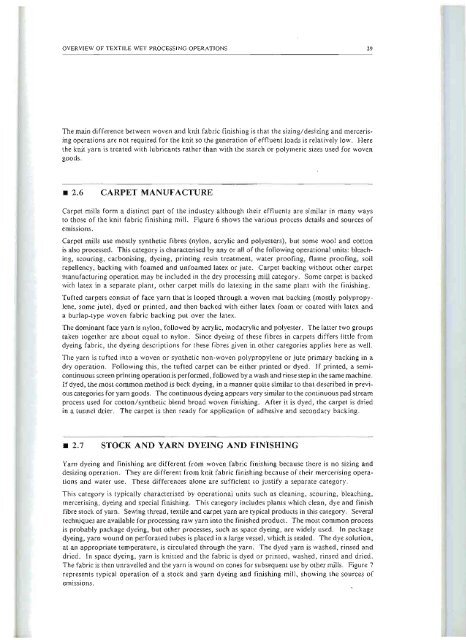Contributor, The Textile Industry and the Environment, UNEP
Contributor, The Textile Industry and the Environment, UNEP
Contributor, The Textile Industry and the Environment, UNEP
You also want an ePaper? Increase the reach of your titles
YUMPU automatically turns print PDFs into web optimized ePapers that Google loves.
OVERVIEW OF TEXTILE WET PROCESSING OPERATIONS<br />
<strong>The</strong> main difference between woven <strong>and</strong> knit fabdc finishing is that <strong>the</strong> sizing/desizing <strong>and</strong> mercerising<br />
operations are not required for <strong>the</strong> knit so <strong>the</strong> generation of effluent loads is relatively low. Here<br />
<strong>the</strong> knit yarn is treated with lubricants ra<strong>the</strong>r than with <strong>the</strong> starch or polymeric sizes used for woven<br />
goods.<br />
• 2.6 CARPET MANUFACTURE<br />
Carpet mills form a distinct part of <strong>the</strong> industry although <strong>the</strong>ir effluents are similar in many ways<br />
to those of <strong>the</strong> knit fabric finishing mill. Figure 6 shows <strong>the</strong> various process details <strong>and</strong> sources of<br />
emissions.<br />
Carpet mills use mostly syn<strong>the</strong>tic fibres (nylon, acrylic <strong>and</strong> polyesters), but some wool <strong>and</strong> cotton<br />
is also processed. This category is characterised by any or all of <strong>the</strong> following operational units: bleaching,<br />
scouring, carbonising, dyeing, printing resin treatment, water proofing, flame proofing, soil<br />
repellency, backing with foamed <strong>and</strong> unfoamed latex or jute. Carpet backing without o<strong>the</strong>r carpet<br />
manufacturing operation may be included in <strong>the</strong> dry processing mill category. Some carpet is backed<br />
with latex in a separate plant, o<strong>the</strong>r carpet mills do Jatexing in <strong>the</strong> same plant with <strong>the</strong> finishing.<br />
Tufted carpets consist of face yarn that is looped through a woven mat backing (mostly polypropylene,<br />
some jute), dyed or printed, <strong>and</strong> <strong>the</strong>n backed with ei<strong>the</strong>r latex foam or coated with latex <strong>and</strong><br />
a burlap-type woven fabric backing put over tbe latex.<br />
<strong>The</strong> dominant face yarn is nylon, followed by acrylic, modacrylic <strong>and</strong> polyester. <strong>The</strong> latter two groups<br />
taken toge<strong>the</strong>r are about equal to nylon. Since dyeing of <strong>the</strong>se fibres in carpets differs little from<br />
dyeing fabric, <strong>the</strong> dyeing descriptions for <strong>the</strong>se fibres given in otber categories applies here as well.<br />
<strong>The</strong> yarn is tufted into a woven or syn<strong>the</strong>tic non-woven polypropylel\e or jute primary backing in a<br />
dry operation. Following this, <strong>the</strong> tufted carpet can be ei<strong>the</strong>r printed or dyed. If printed, a seOlicontinuous<br />
screen printing operation is performed, followed by a wash <strong>and</strong> rinse step in <strong>the</strong> same machine.<br />
If dyed, <strong>the</strong> most common method is beck dyeing, in a manner quite similar to that described in previous<br />
categories for yarn goods. <strong>The</strong> continuous dyeing appears very similar to <strong>the</strong> continuous pad stream<br />
process used for cotton/syn<strong>the</strong>tic blend broad woven finishing. After it is dyed, <strong>the</strong> carpet is dried<br />
in a tunnel drier. <strong>The</strong> carpet is <strong>the</strong>n ready for application of adhesive <strong>and</strong> secondary baCking.<br />
• 2.7 STOCK AND YARN DYEING AND FINISHING<br />
Yarn dyeing <strong>and</strong> finishing are different from woven fabric finishing because <strong>the</strong>re is no sizing <strong>and</strong><br />
desizing operation. <strong>The</strong>y are di fferent from knit fabric finishing because of <strong>the</strong>ir mercerising operations<br />
<strong>and</strong> wa ler use. <strong>The</strong>se di fferences alone are sufficient lO justify a separate category.<br />
This category is typically characterised by operational units such as cleaning, scouring, bleaching,<br />
mercerising, dyeing aod special finishing. This category includes plants which clean, dye <strong>and</strong> finish<br />
fibre stock of yarn. Sewing thread, textile <strong>and</strong> carpel yarn are typical products in this category. Several<br />
techniques are available for processing raw yarn into <strong>the</strong> finished product. <strong>The</strong> most common process<br />
is probably package dyeing, but o<strong>the</strong>r processes, such as space dyeing, are widely used. In package<br />
dyeing, yarn wound on perforated tubes is placed in a large vessel, which is sealed. <strong>The</strong> dye solution,<br />
at an approp(iate temperature, is circulated through <strong>the</strong> yarn. <strong>The</strong> dyed yarn is washed, rinsed <strong>and</strong><br />
dried. In space dyeing, yarn is knitted <strong>and</strong> <strong>the</strong> fabric is dyed or printed, washed, rinsed <strong>and</strong> dried.<br />
<strong>The</strong> fabric is <strong>the</strong>n unravelled <strong>and</strong> <strong>the</strong> yarn is wound on cones for subsequent use by o<strong>the</strong>r mills. Figure 7<br />
represents typical operation of a stock <strong>and</strong> yarn dyeing <strong>and</strong> finishing mill, showing <strong>the</strong> sources of<br />
emissions.<br />
29

















